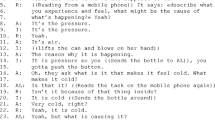Abstract
This paper briefly reports the outcomes of an action research inquiry on the use of blogs, MS PowerPoint [PPT], and the Internet as learning tools with a science class of sixth graders for project-based learning. Multiple sources of data were essential to triangulate the key findings articulated in this paper. Corresponding to previous studies, the incorporation of technology and project-based learning could motivate students in self-directed exploration. The students were excited about the autonomy over what to learn and the use of PPT to express what they learned. Differing from previous studies, the findings pointed to the lack information literacy among students. The students lacked information evaluation skills, note-taking and information synthesis. All these findings imply the importance of teaching students about information literacy and visual literacy when introducing information technology into the classroom. The authors suggest that further research should focus on how to break the culture of “copy-and-paste” by teaching the skills of note-taking and synthesis through inquiry projects for science learning. Also, further research on teacher professional development should focus on using collaboration action research as a framework for re-designing graduate courses for science teachers in order to enhance classroom technology integration.
Similar content being viewed by others
References
Almås AG, Krumsvik R (2007) Digitally literate teachers in leading edge schools in Norway. J In-Service Educ 33(4):479–497
American Association of School Librarians (AASL) and Association for Educational Communications and Technology (AECT) (1998) Information literacy standards for student learning. http://www.ala.org/ala/mgrps/divs/aasl/aaslarchive/pubsarchive/informationpower/InformationLiteracyStandards_final.pdf. Retrieved 1 March 2010
Auer NJ, Krupar EM (2001) Mouse click plagiarism: the role of technology in plagiarism and the librarian’s role in combating it. Libr Trends 49(3):415–432
Barak M, Dori YJ (2005) Enhancing undergraduate students’ chemistry understanding through project-based learning in an IT environment. Sci Educ 89(1):117–139
Barron B, Schwartz D, Vye N, Moore A, Petrosino A, Zech L, Bransford, & The Cognition and Technology Group at Vanderbit (1998) Doing with understanding: lessons from research on problem-and project-based learning. J Learn Sci 7(3):271–311
Bartsch RA, Cobern KM (2003) Effectiveness of PowerPoint presentations in lectures. Comput Educ 41(1):77
Baumfield V, Hall E, Wall K (2008) Action research in the classroom. Sage, Los Angeles
Burke LA, James K, Ahmadi M (2009) Effectiveness of PowerPoint-Based lectures across different business disciplines: an investigation and implications. J Educ Bus 84(4):246–251
Churchill D (2009) Educational applications of Web 2.0: using blogs to support teaching and learning: original articles. Br J Educ Technol 40(1):179–183
Clark J (2008) Powerpoint and pedagogy: maintaining student interest in university lectures. Coll Teach 56(1):39–44
Danielson C (2007) Enhancing professional practice: a framework for teaching, 2nd edn. Association for Supervision and Curriculum Development, Alexandria
Dastani M (2002) The role of visual perception in data visualization. J Vis Lang Comput 13(6):601–622
Dawson V, Forster P, Reid D (2006) Information communication technology (ICT) integration in a science education unit for preservice science teachers; students’ perceptions of their ICT skills, knowledge and pedagogy. Int J Sci Math Educ 4(2):345–363
Dede C (1998) The scaling-up process for technology-based education innovations. In: Dede C (ed) Learning with technology. ASCD, Alexandria, pp 199–215
Eisenberg MB (2008) Information literacy: essential skills for the information age. J Lib Inf Technol 28(2):39–47
Ellery K (2008) An investigation into electronic-source plagiarism in a first-year essay assignment. Assess Evaluation High Educ 33(6):607–617
Grant M (2002) Getting a grip on project-based learning: theory, cases and recommendations. Meridian: A Middle School Comput Technol J 5(1):83
Kerawalla L, Minocha S, Kirkup G, Conole G (2009) An empirically grounded framework to guide blogging in higher education. J Comput Assist Learn 25(1):31–42
Kinchin I (2006) Developing PowerPoint handouts to support meaningful learning. Br J Educ Technol 37(4):647–650
Krumsvik R (2006) The digital challenges of school and teacher education in Norway: some urgent questions and the search for answers. Educ Inf Technol 11(3–4):239–256
Marx R, Blumenfeld P, Krajcik J, Soloway E (1997) Enacting project-based science. Elem School J 97(4):341–358
McPherson S (2009) A dance with the butterflies: a metamorphosis of teaching and learning through technology. J Early Child Educ 37(3):229–236
Metros SE (2008) The educator’s role in preparing visually literate learners. Theory Pract 47(2):102–109
Pettersson R (2009) Visual literacy and message design. TechTrends 53(2):38–40
Probert E (2009) Information literacy skills: teacher understandings and practice. Comput Educ 53(1):24–33
Savoy A, Proctor RW, Salvendy G (2009) Information retention from PowerPoint™ and traditional lectures. Comput Educ 52(4):858–867
Sosa T (2009) Visual literacy: the missing piece of your technology integration course. TechTrends 53(2):55–58
Stringer E (2007) Action research in education, 2nd edn. Prentice Hall, Upper Saddle River
Su KD (2008) An integrated science course designed with information communication technologies to enhance university students’ learning performance. Comput Educ 51(3):1365–1374
Thomas JW (2000) A review of research on project-based learning. Autodesk Foundation, San Rafael. http://bobpearlman.org/BestPractices/PBL_Research.pdf. Retrieved 9 March 2011
Walraven A, Brand-gruwel S, Boshuizen HPA (2008) Information-problem solving: a review of problems students encounter and instructional solutions. Comput Hum Behav 24(3):623–648
Wilson B (ed) (1996) Constructivist learning environments: case studies in instructional design. Educational Technology Publications, Englewood Cliffs
Yeh HT, Cheng YC (2010) The influence of the instruction of visual design principles on improving pre-service teachers’ visual literacy. Comput Educ 54(1):244–252
Yore LD, Bisanz GL, Hand BM (2003) Examining the literacy component of science literacy: 25 years of language arts and science research. Int J Sci Edu 25(6):689–725
Author information
Authors and Affiliations
Corresponding author
Rights and permissions
About this article
Cite this article
Wang, Ch., Ke, YT., Wu, JT. et al. Collaborative Action Research on Technology Integration for Science Learning. J Sci Educ Technol 21, 125–132 (2012). https://doi.org/10.1007/s10956-011-9289-0
Published:
Issue Date:
DOI: https://doi.org/10.1007/s10956-011-9289-0




